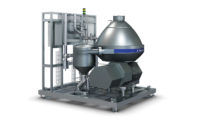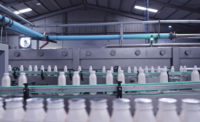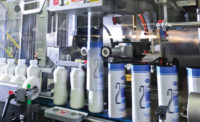The demand for shelf-stable and extended-shelf-life (ESL) products continues to grow. According to Transparency Market Research, the worldwide aseptic packaging market is expected to have a compound annual growth rate of 10.2% during the period of 2017-2024.
“An established food and beverage industry along with an elevated level of awareness among consumers regarding the ill effects of preservatives are factors driving the growth of the market,” says Pune, India-based Market Research Insights in its “Aseptic Packaging Market Research Report 2019.” “Due to high disposable income, the consumption of packaged food is considerably high in [the Americas], which generates massive demand for aseptic packaging.”
But today’s consumers also are asking more from their food and beverages. Not only do they want products that are safe to consume for longer and longer periods of time, they also look for products that offer additional benefits such as higher protein.
Fortunately, today’s processing equipment suppliers are coming up with new and innovative ways to produce these increasingly complex formulations via aseptic and ESL processing.
A new reality
As milk consumption declines, dairy processers are looking to add more value to their products to bring people back to the milk aisle, said Aamer Karim, application engineer for GEA Group, Düsseldorf, Germany.
“Aseptic dosing for DHA [docosahexaenoic acid], vitamins and enzymes has been a particular interest area for dairy processors in recent years, in addition to high-protein, oat- and chocolate-based milk products,” he added.
This new generation of dairy products is increasingly complex to process, Karim noted. Qualities such as viscosity and stability are different from traditional dairy products, and aseptic/ESL equipment has to account for these changes.
“This, in turn, affects the production up-time for processing equipment, and quality is not consistent for different products,” he said.
For its part, GEA came up with an ultra-high-temperature infusion technology system that works with these value-added drinks.
“GEA infusion technology is the most delicate heat treatment available in the market and yields sensory results similar to conventional pasteurization systems while increasing the shelf life manyfold,” Karim explained.
Plant-based problems
As in other parts of the food and beverage world, plant-based proteins are driving changes and innovations in aseptic/ESL processing, too.
“We have seen a number of new products being introduced into the market from nontraditional directions,” said David M. Miles, executive vice president, Microthermics, Raleigh, N.C. “These include many milk replacements such as vegan milks, oat milks, as well as milks from hemp, peas, nuts, flax and other grains and more.”
With these new product types come new challenges in terms of creating shelf-stable, sterile offerings. Plant-based proteins can’t be processed in the same way as dairy proteins, Miles added. This means suppliers are inventing new technologies that can handle the formulation issues of dairy alternatives.
“Mother Nature has a fairly heat-stable formula in milk, and replicating that with a formula using alternate and/or plant-based ingredient sources can be difficult,” he said. “These products can suffer from separation, changes in taste/color/texture and fouling in the heat exchangers. However, using the right processes such as steam injection and/or carefully optimized indirect heating, we have seen many talented formulators create a number of very good products.”
Flexibility wins
Plants today are running multiple lines for products with different formulation requirements, said Jean Pierre Berlan, processing director for U.S. and Canada, Tetra Pak, Lausanne, Switzerland. This can range from plant-based products to protein-enriched beverages to ready-to-drink coffee and tea. This means processors are looking for equipment that can be flexible for many needs.
“The new lines we have been installing recently have had an increasingly complex design to accommodate a wide-range of processing steps and modes,” Berlan said.
Additionally, Berlan added, many products are being produced by a network of co-manufacturers, which ups the need for adaptable machinery.
GEA helps its customers create flexible equipment by allowing customers to test their new or existing products at its pilot plant in Ahaus, Germany. There, customers can see and analyze the finished products, Karim said, and this helps GEA customize the process equipment to yield the best results.
“GEA works with customers to come up with customized and flexible solutions, which guarantees best product quality in conjunction with equipment efficiency,” said Karim. “We claim to have [the] longest production hours for the most difficult and complex products.”
Meanwhile, Tetra Pak recently released a new tubular heat exchanger for product-to-product heat recovery with full 3-A Sanitary Standards certification.
“The technology is now advancing towards more flexible systems, using tubular heat exchangers, but still allowing high efficiencies through heat recovery,” said Berlan.
Keep it safe
While processors want to be up to date on what’s new in aseptic/ESL processing, they still care about the basics. According to ProMach, a producer of ESL fillers, that’s ensuring the hygienic design of their processing equipment.
“Based on customer input, we have been targeting hygienic design improvements for little things that could contribute to big problems,” said Bob Adamson, director of marketing – global filling and integrated services for ProMach.
Recent innovations from ProMach’s Federal brand include HEPA enclosure guard doors featuring a frameless door design that eliminates hard-to-clean harborage points and a patent-pending door hinge design that eliminates harborage points, reduces cleaning time and helps ensure a clean ESL filling environment.
Also, New Federal ESL level and net-weight filling systems now feature an ultrahygienic, fully enclosed washdown-rated stainless-steel filler base. The machine’s drive train seals against a wet plant environment, eliminating the potential for moisture to hide and cause problems, ProMach said.
Julian Stauffer, chief operating officer for Packaging Technologies & Inspection LLC (PTI), Hawthorne, N.Y., said he has seen demand for processing technologies with higher and higher bacteria kill log rates. PTI’s Waldner brand is currently developing sterilization technologies that can get to Log 5.
“They are continuously trying to develop a sterilization process to sterilize packages in a safe manner and achieve a higher bacteria kill rate that proves better than H2O2, Claranor pulsed light or UV [ultraviolet] light,” he noted.
For its part, Chemetrics, Midland, Va., introduced both visual and photometric hydrogen peroxide test kits to help ensure both food safety and product quality after aseptic/ESL processing. The tests include the 0-0.5 part-per-million test range, which is critical to routine peroxide residual monitoring in ESL and aseptic packaging applications.
“Small amounts of food-grade hydrogen peroxide are generally recognized as safe for consumption. However, it is widely accepted that residual peroxide must be removed from finished products, as it may cause a detrimental effect on nutritional value and product quality,” Chemetrics said.







